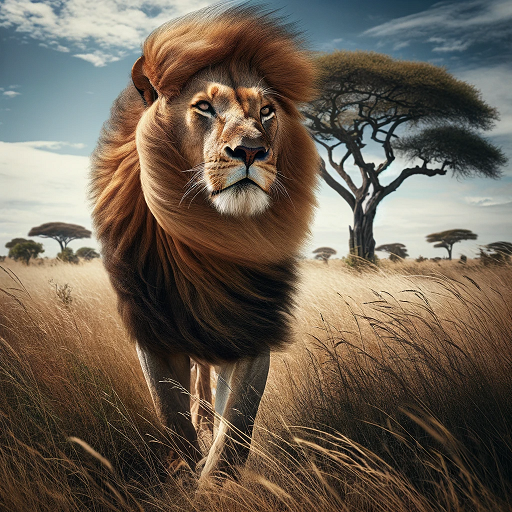In the realm of the animal kingdom, few matchups stir as much intrigue and debate as that of the tiger versus the lion. These two magnificent big cats, apex predators in their respective habitats, possess unique attributes and skills that make this a fascinating and complex comparison.
The Tiger: Stealth, Strength, and Solitude
Tigers, the largest of all wild cats, are solitary hunters known for their incredible strength, agility, and stealth. They are native to diverse habitats in Asia, from the Siberian taiga to the forests of India and Southeast Asia.

Physical Attributes
- Size and Weight: An adult male Siberian tiger, the largest subspecies, can weigh up to 660 pounds and measure over 10 feet in length.
- Strength and Speed: Tigers have powerful muscles, especially in their forelimbs and back, aiding in overpowering prey. They can reach speeds of up to 30-40 mph in short bursts.
Hunting and Prey
Technique
Tigers are renowned for their exceptional hunting skills, predominantly as ambush predators. This technique is a testament to their strategic intelligence and physical prowess. They use their environment to their advantage, often blending seamlessly into the landscape to remain undetected until the opportune moment.

The approach is typically a slow, calculated stalk, followed by a sudden and explosive pounce. This method is highly effective and conserves energy, allowing tigers to tackle prey that is often larger and stronger than themselves. The power of their final pounce lies in their strong hind legs, enabling them to leap distances of over 30 feet in a single bound.
Prey
The tiger’s diet is impressively diverse, reflecting their adaptability to different environments across Asia. They primarily prey on medium to large-sized herbivores, including various deer species, such as sambar, chital, and barasingha. Wild boar also constitute a significant portion of their diet. In some regions, tigers are known to hunt larger and more formidable prey, like the gaur – the largest species of wild cattle – and even water buffalo. These hunting feats showcase the tiger’s incredible strength and the strategic thinking that goes into such challenging pursuits. Their ability to take down such large prey underscores their position as apex predators within their ecosystems.
Adaptability and Endurance
Tigers exhibit a remarkable level of adaptability and endurance, which is crucial for survival in the diverse habitats they occupy. From the freezing cold forests of Siberia to the tropical mangroves of the Sundarbans, tigers have evolved to thrive in a variety of environmental conditions. This adaptability extends to their hunting strategies, dietary preferences, and territorial behaviors.
Their endurance is particularly evident in their territorial patrols and hunting methods. Tigers cover extensive ground to mark and defend their territories, which can span several square miles. This territorial behavior is vital not only for their survival but also for the continuation of their species, as it helps reduce conflicts and ensures genetic diversity.

Furthermore, their endurance plays a critical role during hunting. While they are capable of short bursts of speed, their hunting strategy relies more on patience and stamina. They may track or wait for their prey for hours, and in the case of larger prey, the actual takedown and subsequent kill require sustained physical exertion.
In summary, the tiger’s hunting abilities, marked by stealthy technique and a diverse diet, alongside their adaptability and endurance across various landscapes, are key factors that define their success as solitary apex predators.
The Lion: Social Predator and King of the Beasts
Lions, known as the “King of the Jungle,” are social big cats, living in groups called prides. They are native to Africa, and a small population exists in the Gir Forest of India.
Physical Attributes
- Size and Weight: Male lions are smaller than tigers, with an average weight of around 420 pounds.
- Mane and Protection: The lion’s mane is not just for show; it provides protection during fights, especially around the neck and throat.
Lion Hunting and Prey
Team Hunters
Lions, unique among big cats, have a cooperative hunting strategy, largely attributed to their social structure. This team-based approach is particularly effective in the open savannas of Africa, where their main prey includes large, robust animals such as wildebeests, zebras, and even young elephants. Hunting in groups allows lions to strategize and corner their prey, often targeting the young, old, or weak individuals. This cooperative hunting method increases their success rate significantly compared to solitary hunters.

The coordination and collaboration seen in lion hunts are a remarkable example of social behavior in the animal kingdom. By working together, they can bring down prey that would be formidable for a single lion, demonstrating the power of unity and teamwork in the wild.
Role Distribution
In a lion pride, there is a clear division of roles, particularly in hunting and territory maintenance. Lionesses, the primary hunters of the pride, are smaller, swifter, and more agile compared to their male counterparts, making them more suited for the chase. They often work in tandem, using sophisticated hunting techniques like flanking and ambush. The males, on the other hand, primarily serve as protectors of the pride. They guard the territory against intruders and rival prides, ensuring the safety of the pride members. This role distribution is a key aspect of their survival strategy, allowing each member to contribute effectively according to their strengths.
Social Dynamics and Strength
Lions are known for their complex social dynamics, which play a crucial role in their survival and overall behavior. Living in prides, they exhibit a range of social behaviors unseen in any other big cat species. This social structure aids in their survival, providing numerous advantages such as cooperative hunting, rearing of cubs, and protection against threats.

However, the strength and fighting prowess of a lion in a one-on-one battle differ from their group dynamics. In the context of a pride, lions rely on collective strength and strategy. Isolated from this support system, an individual lion may exhibit different strengths and vulnerabilities. Male lions, while typically involved in defending the pride’s territory, can be formidable opponents in individual combat, thanks to their size, strength, and protective mane. This mane not only serves as a status symbol but also provides a significant advantage in fights by protecting their neck and throat. In contrast, lionesses, adept hunters within the pride, may rely more on agility and tactical intelligence when alone.
In essence, the lion’s social dynamics shape their approach to survival, hunting, and combat. While they are powerful as a group, their individual strengths and strategies also play a crucial role in their adaptability and effectiveness as apex predators.
Head-to-Head Comparison
When comparing tigers and lions in a hypothetical battle, several factors come into play:
Strength and Combat Skills
- While tigers are generally larger and more powerful, lions are battle-hardened from fighting within their prides and fending off rivals.
Hunting Techniques
- Tigers, being solitary hunters, are adept at stealth and surprise, crucial in a one-on-one confrontation.
- Lions, used to hunting in groups, might lack the same level of stealth but are no less formidable in combat.
Endurance and Agility
- Tigers have a slight edge in agility and endurance, crucial in a prolonged battle.
Psychological Factor
- The tiger’s solitary nature means it is more accustomed to fighting alone, possibly giving it a psychological edge.
The Verdict: Who Would Win?
Determining a clear winner in a fight between a tiger and a lion is challenging and speculative. While the tiger has an advantage in size, strength, and agility, the lion’s combat experience and social dynamics should not be underestimated.
In a hypothetical encounter, the odds might slightly favor the tiger due to its sheer physicality and adeptness in solitary combat. Tiger 60% – Lion 40% chance to Win. However, the outcome of such a battle would largely depend on numerous variables, including the age, size, health, experience, and even the temperament of the individual animals.
Conclusion
The tiger versus lion debate is more than just a question of who would win in a fight; it’s a fascinating exploration of two of nature’s most awe-inspiring predators. Both cats are perfectly adapted to their environments and ways of life, making them both champions in their own right. The true winner is the one that continues to thrive and adapt in its natural habitat, contributing to the rich tapestry of our planet’s biodiversity.
For those intrigued by the captivating world of animal matchups and comparisons, here are three recommended reads from our website that align with the themes of tigers and lions:
- Delve into the unique dynamics of predator confrontations in “Tiger vs. Komodo Dragon: A Battle Between Predators of Different Realms”, offering a fascinating comparison of two formidable hunters.
- Explore the world of social hunting and its effectiveness in “Lion vs. Cheetah”, which contrasts the group tactics of lions with the solitary hunting style of cheetahs.
- Uncover the strength and strategy of big cats in “Wolf v. Tiger: Who Would Win in a Carnivore Fight?”, comparing the solitary power of tigers to the pack dynamics of wolves.




